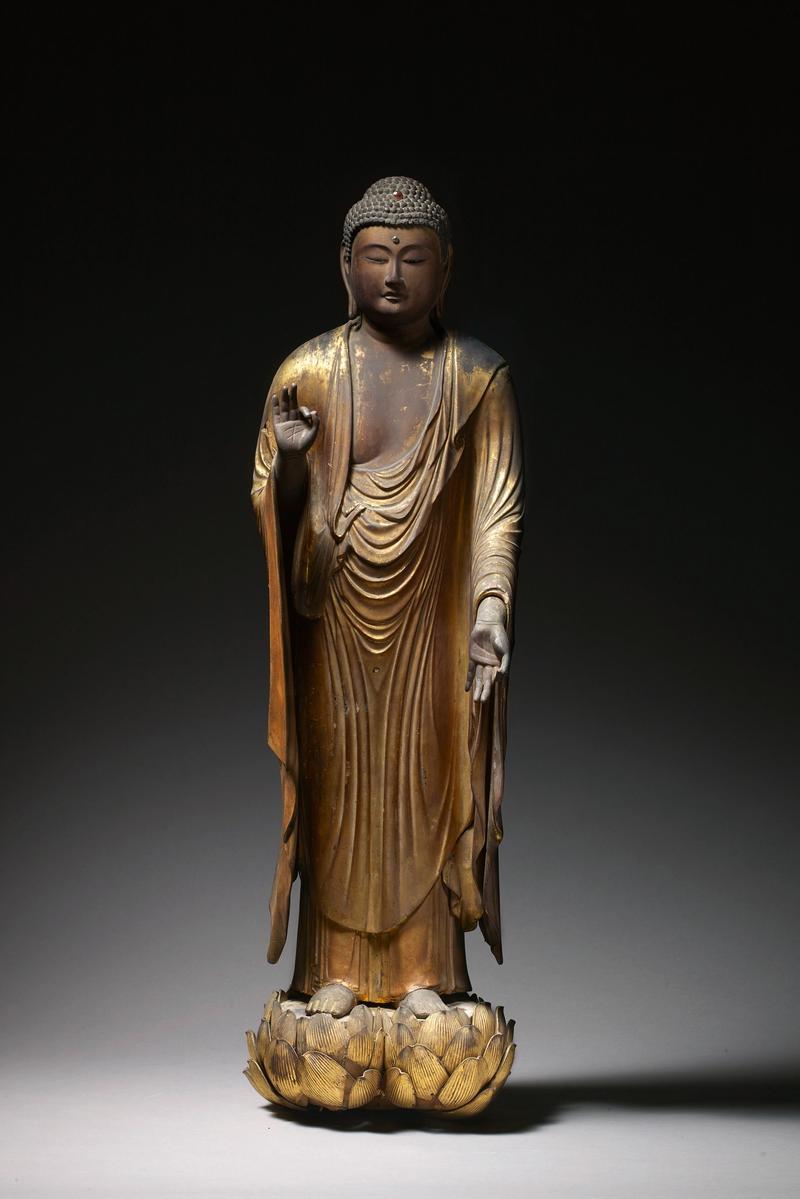A gilt-bronze square kakebotoke (hanging plaque with Buddhist images) adorned with four Esoteric Buddhist deities, each seated on a lotus pedestal, framed by sixteen Wheels of the Law.
top right: Dainichi Nyorai (Mahāvairocana) of Taizōkai (Womb Realm)
top left: Fukūjōju Nyorai (Amoghasiddhi) or Shaka Nyorai (Shakamuni)
bottom right: Amida Nyorai (Amitābha)
bottom left: Dainichi Nyorai (Mahāvairocana) of Kongōkai (Diamond Realm)
Figures: Japan, Heian/Kamakura period, 12th century.
Plaque: Japan, Edo period (1615-1868) or earlier
Dimensions of each figure: H. 11-11.5cm (4¼”) approx.
Kakebotoke (hanging Buddha) are generally circular votive plaques symbolising mirrors, which represent the sacred body of kami (Shintō deities), but could take other shapes such as square, and are adorned with repoussé or cast images most frequently of Buddhist deities. They originate from the practice of Shinbutsu-shūgo (syncretism of kami and buddhas) which was established in the Heian period. One of the few forms of Buddhist art unique to Japan, they can be found both at Shintō shrines and Buddhist temples and are presented as offerings to safeguard the compound and to ensure the prosperity of the Buddhist faith. In the Buddhist context they were hung from the eaves above the main entrance to an Image Hall, or above the frieze rail between the outer and inner sanctums of the shrine for the deity that protected the temple compound. They may also be used to represent hibutsu (hidden Buddha) which are not generally on show to the public.
Dainichi (Great Sun) is the central and supreme deity of the pantheon of Esoteric Buddhism. In origin he has been linked to an ancient sun cult and to the Zoroastrian god of light, Ashura Mazda. In Brahmanical literature the appellation Vairocana (primordial or supreme Buddha) appears, for example, as the name of a legendary king and of the king of the Ashura. In Buddhism he assumes a central role in Esoteric Buddhism he eventually took the place of Shaka (the Historical Buddha), as expositor of the Buddhist teachings, becoming the central figure in the Esoteric Buddhist pantheon as represented by the Taizōkai Mandara (Womb World Mandala) and Kongōkai Mandara (Diamond World Mandala). In Japan Dainichi also figures among the so-called Jūsanbutsu (Thirteen Buddhas), presiding over the memorial service held on the 12th anniversary of a person's death.
Dainichi differs iconographically from other Buddhas in that he is represented in the form of a Bosatsu, seated, wearing silk robes and accessories such as armlets and bracelets, and having long locks of hair. He also wears a Gochi Hōkan (five-wisdom bejewelled crown) on his head, symbolising his identity with the Gobutsu (Five Buddha) and Gochi Nyorai (the five wisdoms) attributed to them.
Dainichi may be also identified by his distinctive hand-gestures: in the Taizōkai Mandara he forms the hokkai jōin (Concentration seal of the Dharma-realm), with both hands lying on his lap, right on top of left, palms upward and thumbs touching, while in the Kongōkai Mandara he forms the chiken-in (seal of the knowledge fist), with the clenched right hand posed over the extended index finger of the otherwise clenched left hand.
For more about kakebotoke and further examples, see:
Bunkachō (Agency for Cultural Affairs) ed., Jūyō-bunkazai (Important Cultural Property) 24, Kōgeihin (fine crafts) I, (Tokyo, 1976), p40-53.
Naniwada Tōru, Nihon no bijutsu (Art of Japan), No. 284 Kyōzō to Kakebotoke (Votive Buddhist mirrors and plaques), (Tokyo, 1990).
For the kakebotoke adorned with Buddhist images in elaborate robes from the late Heian period, see ditto, image no. 4 and 6.
For the gilt-bronze Buddhist figures from the Heian period, see Special Exhibition of Gilt-Bronze Buddhas from China, Korea and Japan, Tokyo National Museum, 1987, p298-325.
In particular for the comparable cast gilt-bronze images of the Esoteric deities from the late Heian period (12th century), see ditto, p312-314, no.216 (the collections of Tokyo National Museum and Seigantoji temple, Wakayama).
Buddhist Art

A kakebotoke

Zenkoji Kannon Bosatsu

A nyoi (priest staff) formed from natural reishi (bracket fungus) mushrooms

Buddhist wood panels

A kakemono with the monk Hōnen

A lacquer and gilt wood figure of a seated Amida Nyorai (Amitābha) dressed in a flowing robe

A wood figure of Amida Nyorai, Heian/Kamakura period

Amida Buddha

Jizō Bosatsu

Amida Buddha

A silk kakemono with Kannon

An iron nyoi

Zushi with Kannon

A bronze kakebotoke of Kannon















